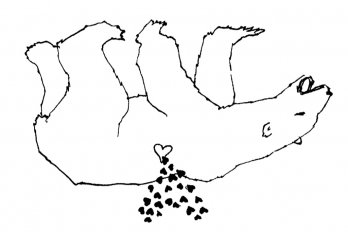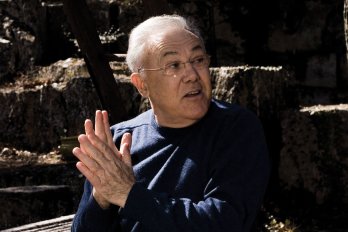If things devolve and decentralize in a lot of ways, then what is Canada beyond a concept
—Liberal Member of Parliament Ken Dryden
Support people rather than places.
“—From Bronze to Gold: A Blueprint for Canadian Leadership in a Transforming World,” Canadian Council of Chief Executives
In real estate, location is everything; in politics, it is timing (the election call, the quick riposte). Of course, just as real-estate agents often fail to mention the second most important feature of any house—who the neighbours are—in politics, clever timing is often the result of prepared spontaneity (i.e. “fluffing” the candidates) and remaining silent about key facts or intentions. No need to mention the twenty-year-old roof. Let them ask.
While the brilliance of Stephen Harper’s election campaign rested on the slogan “Stand Up for Canada,” now that the house has been bought and the dust has settled our new prime minister has a problem: his internal clock is set to a different era. Slogans aside, as Canadians consider their nation-building options for the twenty-first century, Harper’s concept of our state remains rooted in the nineteenth century. Eschewing the Charter of Rights and Freedoms, the magnanimity of redistributed wealth across a vast and variegated landscape, and the current pressing question of a new deal for cities, Harper sees his job as resuscitating the 1867 British North America Act. In dealing with the supposed “fiscal imbalance” between Ottawa and the provinces—framed as ballooning federal surpluses versus escalating provincial deficits—expect him to give us first a history lesson and then a magical carpet ride backward in time.
Even in our ahistorical age, constitutional experts and historians continue to debate the precise meaning of the bna Act—whether First Nations peoples were properly accounted for; whether Confederation would have happened when it did without the US Civil War (1861-1865); whether it is an Enlightenment document at all. The arguments pro and con fill the copy inches of books and the talk of lectures. But on the key issue of the division of powers, Harper’s interpretation is clear: Section 91 of the bna Act establishes that Ottawa is in charge of “peace, order, and good government” (or pogg); Section 92 grants the provinces the rest (and no acronym could possibly encapsulate such a voluminous category).
“To tax is to govern,” as the saying goes, but, like democracy itself, pogg is not something the average citizen can put in a wheelbarrow and take home. We cannot taste or feel pogg and, even at the best of times, it is difficult to see or measure. The “rest” (Section 92) are provincial matters—everything from schooling to (now) daycare, natural resources, jurisdiction over cities, and health care; they are easily quantifiable and have direct bearing on people’s lives. So, in Harper’s mind the syllogism is simple: pogg is important, but it is only a concept; in real terms, it is a cipher (in the arithmetical sense), meaning that it denotes no specific amount and is used simply to occupy space. Therefore, the way to ensure “peace, order, and good government” is to relieve Ottawa of the burden of collecting taxes on all matters beyond the costs associated with defending our borders and talking to Mr. Bush.
Put more simply, the federal House of Commons should not be a “tax room” at all. Rather, thirteen smaller rooms —the provincial and territorial legislatures—should tax and govern the nation. Harper’s vision is to set the provinces free. Free to tax, free to spend, free to do as they will, and free to be accountable. And in this application of nineteenth-century wisdom (the bna Act, like the Bible, herein interpreted literally), Harper dreams of a different state of nature: endless competition between the provinces, or rather, between the people who happen to inhabit these constellations. He dreams of the regions playing British bulldog with little or no federal parenting, some successful in bagging recruits—head offices, construction magnates, private health care clinics—and for the others: well, too bad…
“Stand Up for Canada” masks just how complicated Harper truly is. For years, he travelled over rough terrain, navigating the troubled waters of the Reform Party, then the National Citizens’ Coalition, then the Canadian Alliance. He has been bruised and battered but Harper has also been absolutely resolute in his pursuit of Olympic gold: the prime minister’s chair. Now, having achieved this lofty station, since he sees his job simply as providing pogg—an existential concept full, as it were, of non-being—he is basically saying, “There is nothing to do… beyond national defence and, perhaps, foreign affairs.”
But before our reluctant prime minister can orchestrate his own demise, he has some work to do and games to play. The January election awarded Harper a Conservative minority with regional holes. Most tellingly, Canada’s three major cities—Toronto, Montreal, and Vancouver—had opted out, choosing only Liberal or New Democratic Party representatives. Unbowed and knowing that in politics timing is currency, with Parliament in recess, the moment was ripe for some shadowy business.
The public justification given for naming Liberal unbeliever David Emerson (Vancouver) and the unelected Michael Fortier (Montreal) Ministers of the Crown was to make the Conservative Cabinet “representative of the major interests of the country.” That is, the decisions may have been undemocratic and contemptuous of the local will but Harper was “standing up for Canada.” As the prime minister moved the furniture around in his mind, the new feng shui design said: “Good government not only justifies these moves, it requires them.”
In backrooms, Harper and his mandarins no doubt delighted in their “gotcha” putsch—Emerson for Belinda Stronach; Fortier for a Pierre Pettigrew or a Stéphane Dion—but in the foreground, as Parliament reconvenes, Canadians are facing a brave new political world: a world where two wrongs make a right; where political parties do not have to content themselves with the will of the governed; and where a pogg prime minister presides over not a country but a concept.
Strangely, national defence and foreign affairs seem to be where Harper’s continental neighbour, US President George Bush, also likes to hang his hat. Bush too cleaves to a rather literalist translation of America’s founding document. Long attracted to the immediate fixes of empire and to a Straussian rejection of participatory democracy, could it be that Harper is actually taking his cue from the US administration There, the contempt for due process is bordering on the absurd. While Jon Stewart treated the administration with kid gloves on Oscar night, that morning President Bush arrived home from a whirlwind tour through South Asia. While in India, flouting domestic law and international obligations, Bush signed a nuclear co-operation pact with a country that has consistently refused to join the Nuclear Non-Proliferation Treaty. (The pact, if ratified by the Senate, would subject India’s civilian reactors to the strictures of the International Atomic Energy Agency, but also allow it to keep two reactors geared toward India’s nuclear-weapons program beyond international observation.)
Then, like a cowboy on ecstasy, Bush saddled up and headed off to Pakistan, India’s chief competitor in the region, and, like Iran, a country with nuclear ambitions of its own. Saying “No” to Pakistan’s desire for nuclear expansion, after saying “Not in my lifetime” to Iran’s nuclear requests, has left the impression that what is good for India’s Hindus is not good for the region’s Muslim countries. In summing up his “historic” visit, Bush said, “I explained that Pakistan and India are different countries with different needs and different histories.” Well, pardner, you might have added, “I simply prefer the blue God of the Hindus, the funny one with many arms and hands upturned, to that Allah figure y’all get excited about.”
Bush’s reckless internationalism is framed by the twin slogans, “You’re either with us or against us” and “Might is right.” Before these, “Stand Up for Canada” appears benign. The US president may yet create a clash of civilizations—somewhere, sometime, because the fireworks will be splendid—or he may, more prosaically, just end history, but in the meantime small fish love to play in big ponds, and Harper might launch an experiment of his own. (This is a man, after all, who has never run a business and who is thus not wholly inoculated against the power of big ideas, who is not comfortable—unless scripted to be—in café society, and whose adult life has been spent in the arena of policy wonkdom.)
Harper is now charge and therefore more alone, more vulnerable. And just in case a Red Tory (say, a Peter MacKay) were to gain his ear and lead him astray, or just in case, on a strange whim discordant with his hard-wiring, Harper gets any bright ideas about honouring his pledge to “Stand Up for Canada,” of putting meat and bones on “peace, order, and good government” by telling the provinces how to behave, predictable players have lined up to ensure that their man remains their man.
For transparent reasons, separatist Quebecer Gilles Duceppe—he who, due to some strange conflation of Canadian values, sits in the federal Parliament only to fracture it—said that he would support Harper’s minority government. Alberta’s Ralph Klein floated the trial balloon of putting health care delivery in private hands…just to see how Harper as prime minister would react compared with Harper as co-author of the Alberta “firewall” letter. Less transparently, on February 21, 2006, the Canadian Council of Chief Executives (ccce) released “From Bronze to Gold: A Blueprint for Canadian Leadership in a Transforming World.”
Like Harper’s campaign, the essay is masterfully scripted. Calm, fluid, moderate in presentation, and, at first blush, moderate in its prescriptions, “From Bronze to Gold” begins seductively with pleasing bromides: “We believe in Canada;” “Canada has many strengths;” “Canada must build on its success.” The imperative “must” is mitigated by language evocative of primary-school report cards and by praise for “the hard choices made by Canadians during the 1990s [which] have produced real dividends,” and “[Canada’s] economic growth has been the best in the G7 over the past five years, driving the unemployment rate to its lowest levels since the 1970s….” So all is well, according to the who’s who of corporate Canada Read on, Macduff.
The ccce admits that the federation has been a success story and that Canada has reached the podium, if only to win Olympic bronze. And so, here and there and off and on, the praise and positive reinforcement reappear. But there are ominous storm clouds forming—China, India, terrorism, rampant global competition—and by the mid-point of “From Bronze to Gold” the imperatives become more insistent. The ccce has done a credible job of embedding research into a narrative, but ultimately the executives are not novelists happy with the lilt and rhythm of description, character, and scene-setting; they are doctors with prescriptions to fill.
The ccce has learned to bow before the oracle of Brian Mulroney—the last successful Conservative politician—and to listen to his mantra: pacify, placate, work the room (and the room is 6,000 kilometres wide), leave all meaningful material to fine print or to back pages. Indeed, while the press rightly focused on the essay’s immediately arresting prescriptions (and those that appear relatively early)—the elimination of federal social transfers, scrapping the goods and services tax, and shifting “tax room” to the provinces; the further devolution of Ottawa’s role to exclusive jurisdiction over foreign affairs and national defence, and to a mere enabler in such areas as postsecondary education, the environment, and health—it is not until right near the end that “From Bronze to Gold” provides the ultimate revelation.
It comes quietly, on page twenty-one of the twenty-three-page document, and is cast innocently as a creative idea, indeed as a “creative leap to consider,” and it is simply stated: “Support people rather than places.”
In the context of a narrative predicated on the counterintuitive notion that when times are good the moment for fundamental change has arrived, such an idea is not much of a leap at all. Set against the happy backdrop of eliminating taxes on creativity, cutting them on investment, learning from children, freeing aboriginal Canadians from a reserve mentality, dramatically improving labour mobility, and, in short, a full-blown appeal to our very selves, such a statement washes over the reader. For so many countries—perhaps for most—such an individualist approach seems eminently sensible, even desirable. But Canada is not most countries, and any reading of our literature—not just Margaret Atwood’s Survival, Dionne Brand’s Land To Light On, or Gilles Vigneault’s “Mon Pays,” but also countless foundation myths, and, in fact, countless policy manuals since the bna Act—reveals that Canada has always been about place, about rendering and securing an unlikely country in a godforsaken landscape.
From building the railway, settling the Prairies, and creating the Canadian Broadcasting Corporation, to adopting the peculiar idea that individual medical care is a shared responsibility, Canada has always been about knitting places together and about the sublimation of personal desire needed to do so. It has been this way for very simple reasons: “I got mine, every crumb for himself” makes no sense before the monumental challenge of this place; and investing in places means securing national sovereignty over them. Without investing in the North, the Northwest Passage will fall to the highest bidder; without two cities in Saskatchewan and another one in Manitoba, our claim to the Prairies might be lost.
While Canada is governed by a Charter that prioritizes individual rights and freedoms, “Support people rather than places” actually runs against the entire drift of our evolving nation-state. Such a prescription would unravel equalization payments—that clever strategy, consistent with a history of settling difficult places, of sending money to less advantaged regions because, for example, Newfoundland needs Cornerbrook as much as it needs St. John’s. And it would unleash a level of competition between clusters of people that would, in the end, leave enormous tracts of land deserted.
In truth, “Support people rather than places” informs all of “From Bronze to Gold,” including Appendix II, a handsome ten-page list of 148 corporate executives—a handful of women, a few ceos located in the US, vast stretches of this place strikingly under-represented, and the usual suspects in a majority position. The ccce looks at Canada and sees in its institutions and stabs at equalization a failed socialist utopia, a structural-engineering project gone terribly wrong. And, unlike the old directors of the Hudson’s Bay Company—gone now, swept up by a bigger, more voracious American machine—who might have taken this age of soaring corporate profits and lagging investment and said, “We ought to do something about this place,” the ceos of the ccce argue that it is people who determine place, that Hobbes was right, Rousseau fanciful, that the natural order of things is unbridled competition, and that the manifest destiny of some will and must triumph.
Canada has always been a concept. In this it is no different than any other nation-state. But in America, the people are the foundation myth. In Canada, it is the land we light on.
Mr. Harper, against the best wishes of a few and perhaps against your own instincts and desires, the task ahead is monumental, and it is about place. May you govern yourself accordingly, or may your reveries be punctuated by the ghosts of Ignatieff, Rae, Dryden, or even Stronach.





